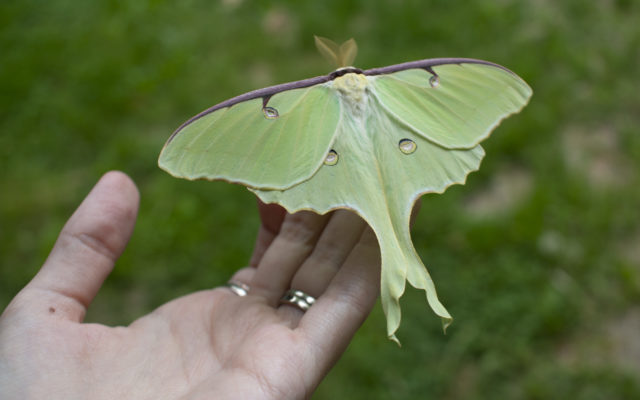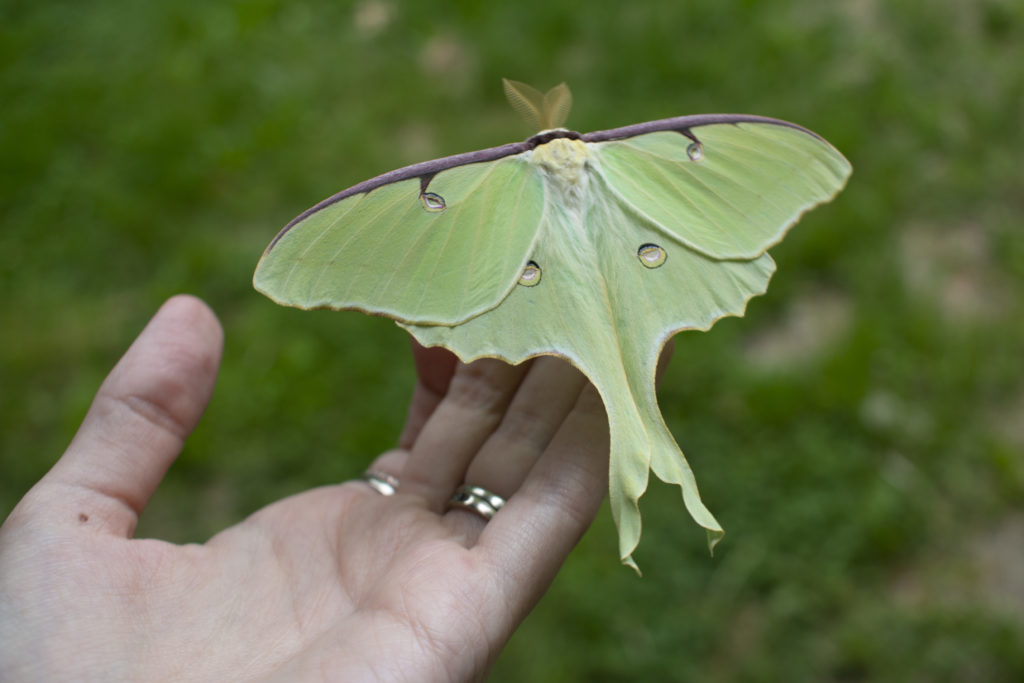
Wild creatures made working from home less lonely during the pandemic
By Aislinn Sarnakci, Bangor Daily News Staff
I gazed past my computer with wide eyes, then leaned forward, following the hummingbird’s path to a nearby birch tree, where it perched on the tiniest twig. Spectacular, I thought. Look at the shimmering red feathers on its throat.
“Aislinn, are you watching birds again?” my editor, Sarah, asked with amusement in her voice.

WILDLIFE VISITORS — Luna moths are among the many creatures that visited Aislinn Sarnacki’s yard during the summer of 2020.
It was a summer day, and miles away, via video call, my colleague could easily interpret my wandering eyes and the look of wonder on my face. It wasn’t the first time I’d been distracted by wildlife during our virtual morning meetings.
Deep in the woods, on a hill above a lake, my home is visited by a variety of wild animals year round. But I didn’t realize just how alive the property was until I started working from home due to the COVID-19 pandemic.
It started rather abruptly in March. One week I was working in a bustling newsroom in downtown Bangor, surrounded by coffee-fueled journalists, and the next, I was sitting at a desk in a quiet room in my home — alone.
There are plenty of things I enjoy about working from home, including my proximity to nature. Now all I have to do is look past my computer screen and I’m viewing a slice of wilderness.
My “yard” is more like a forest clearing, with soft beds of moss, tall ferns and sapling pines. It also features a monstrously large bird feeder, which my husband and I pieced together at the beginning of the COVID-19 outbreak. Using a hodgepodge of construction materials and driftwood that we’d collected from a local beach, we built a large circular platform covered with a V-shaped roof. Then, in our yard, we used irregular granite blocks to construct a large pedestal. The resulting structure resembles an old wishing well, filled with seeds.
Also visible from my office window is a hummingbird feeder, which dangles from the branch of a beech tree during warm months. And beyond the fern patch is a flower bed dominated by unruly roses.
As spring progressed this year, I started jotting down the wildlife I saw or heard from my office window. On a rainy day in early April, I heard my first loon call of the season. And on April 14, a yellow-bellied sap sucker flew straight into my office window, causing my heart to skip a beat. Fortunately, the sizable woodpecker seemed to recover quickly as it clung to a nearby tree.
On my lunch break, I almost always venture outside, which presents even more opportunities to see local wildlife. Suspended in woodland pools, frog and salamander eggs appeared at the end of April. And on May Day, a host of goldfinches invaded my feeder in a flurry of vibrant yellow.
On May 2, I spied a plump white-tailed deer walking up the gravel road leading to my house. I surmised she must have been carrying a fawn or two.
In June, I discovered large toads hopping across my yard. A garter snake took up residence in the rock wall lining the flower bed. And moths began to emerge, swarming our windows and porch light at night. This inspired a new construction project: a “mothing” station. The set-up included a large ultraviolet light suspended over a sheet that we nailed to the side of our shed. The light attracted a variety of moths, which then landed on the sheet.
I set an alarm so I could wake in the middle of the night to take photos of the moths, which I later identified using the iNaturalist mobile app. One of my favorites was a pink underwing moth, which was drab until it spread its wings, revealing a pattern of vibrant pink and red on its underwings. The luna, polyphemus, rosy maple, spiny oak-slug and silver-spotted fern moths also became personal favorites.
A horde of dragonflies arrived, too. In fact, I saved one from drowning in my dog’s kiddie pool. I held it in my hands for a few minutes as it dried off, then cheered it on as it flew away. I imagined it gobbling up all of the mosquitoes buzzing around our neck of the woods.
As summer marched on, I developed a new fascination: caterpillars. It started with a pink-striped oakworm moth, which I found at the base of an oak tree, right outside my front door. The caterpillar had a hard body, as if it wore armor. Furthermore, that armor was covered with little black spikes and a beautiful pattern of tiny white dots and thick pink stripes.
During lunch breaks, I looked under leaves and through the grass, finding a wide variety of colorful caterpillars well into the fall. There were fuzzy woolly bears and hairy tussocks, a yellow-and-orange striped owlet caterpillar and a bright pink white-blotched heterocampa caterpillar. In fact, that last one was so goofy in appearance that a commenter on my Instagram page, @actoutdoors, thought it was a dog toy at first glance.
In late September, after weeks of no rain, we enjoyed a midday downpour. And as I typed away at my computer, I was startled by a giant spider called a marbled orbweaver rappelling right in front of my face. Fortunately for me — and the spider — it was outside and I was indoors. Through the window I watched as it quickly descended to the ground on a thread of invisible silk.
Was it going to get a drink? I wondered. Were even the local spiders thirsty during this drought? Too curious to keep working, I donned a raincoat and headed outside, then searched under my office window until I found the spider perched on a weed. Indeed, the eight-legged creature did appear to be taking a drink from a bead of water on the plant. I watched for a while, long enough to witness its rapid climb to the top of the window once more.
These observations of nature were much-needed breaks from working solo at home. By watching and sometimes interacting with local wildlife, I felt a little less alone and a little more connected to my surroundings. In this way, the natural world helped me soldier on in 2020, and I know I’m not alone.
Several people have remarked to me about how much wildlife they’ve seen this year, right in their own backyards. I don’t think it’s necessarily because wild animals were more numerous or less secretive in 2020. I think it’s because, during the pandemic, many of us had more time to look out of our windows and walk around on our properties.
The wildlife has always been there, sharing space with us. We just had to look.
Aislinn Sarnacki can be reached at asarnacki@bangordailynews.com. Follow her on Twitter: @1minhikegirl, and Instagram: @actoutdoors.